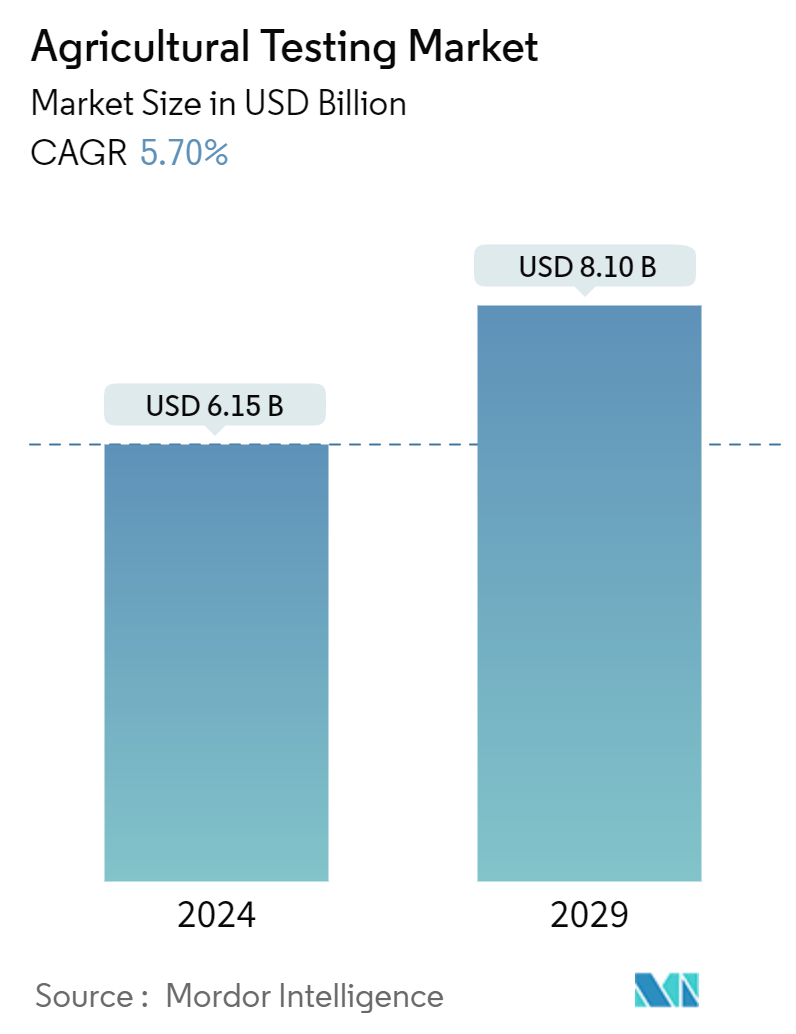Market Size of Agricultural Testing Industry

| Study Period | 2019 - 2029 |
| Market Size (2024) | USD 6.15 Billion |
| Market Size (2029) | USD 8.10 Billion |
| CAGR (2024 - 2029) | 5.70 % |
| Fastest Growing Market | Asia-Pacific |
| Largest Market | North America |
| Market Concentration | Medium |
Major Players
*Disclaimer: Major Players sorted in no particular order |
Agricultural Testing Market Analysis
The Agricultural Testing Market size is estimated at USD 6.15 billion in 2024, and is expected to reach USD 8.10 billion by 2029, growing at a CAGR of 5.70% during the forecast period (2024-2029).
- Agricultural testing involves the examination of samples such as water, soil, and seeds to assess their quality and levels of contaminants. This industry is experiencing significant growth, particularly in developed areas and commercialized regions across the world. Regulations and laws largely drive the market's expansion to ensure environmental safety and improve agricultural productivity.
- Over the next few years, the agricultural testing market is anticipated to rebound strongly, driven by increased demand for farm products, leading to higher production and the need for regular soil testing. Additionally, there is a shift in consumer preferences toward higher standards of food safety and quality, particularly about chemical residues. This is creating a greater need to maintain soil properties for quality production, thus bolstering the market's growth.
- Globalization has necessitated standardized assessment techniques to facilitate the trade of grains and oilseeds. Consequently, exporters and importers are requesting analysis certificates to demonstrate compliance with global quality and safety standards. This has led to an increased demand for testing services related to agricultural outputs, particularly in regions with high agricultural exports. For instance, China saw a significant increase in the value of its brown rice exports from USD 168,867 thousand in 2020 to USD 211,847 thousand in 2022. However, exporters are facing challenges due to mold growth caused by high moisture levels in the grains. The high toxicity of the fungal growth has led to the rejection of brown rice in global markets due to stringent regulations on permissible toxicity levels.
- The agricultural testing market is currently dominated by North America. This is attributed to the region's stringent regulations related to food safety, environment, agriculture, nutritional content, chemicals, and labeling. The presence of numerous agricultural testing service providers in the region is contributing to the market's growth.
Agricultural Testing Industry Segmentation
Agriculture testing refers to analyzing soil, water, seeds, crops, fertilizers, and other agricultural inputs to ensure optimal conditions for plant growth, yield, and safety. It helps in determining soil composition, nutrient levels, pH balance, and potential contamination. The purpose of agriculture testing is to improve crop productivity, quality, and sustainability while minimizing environmental impacts.
The agricultural testing market is segmented by sample (water testing, soil testing, seed testing, bio-solids testing, manure testing, and other samples) and geography (North America, Europe, Asia-Pacific, South America, and Africa). The market sizing has been done in value terms (USD) for all the abovementioned segments.
| Sample | |
| Water Testing | |
| Soil Testing | |
| Seed Testing | |
| Bio-solids Testing | |
| Manure Testing | |
| Other Samples |
| Geography | ||||||||
| ||||||||
| ||||||||
| ||||||||
| ||||||||
|
Agricultural Testing Market Size Summary
The agricultural testing market is experiencing significant growth, driven by increasing regulations and consumer demand for higher food safety and quality standards. This sector involves testing various agricultural samples, such as soil, water, and seeds, to ensure they meet safety and quality standards. The market is expanding rapidly, particularly in developed regions, due to the need for periodic testing to maintain agricultural productivity and environmental safety. North America leads the market, supported by stringent food safety and environmental regulations, as well as a strong presence of agricultural testing service providers. The United States, in particular, shows a robust demand for seed testing, driven by certification requirements for seeds and grains.
The market is moderately consolidated, with key players like Eurofins Scientific, R J Hill Laboratories Ltd, Agilent Technologies, Inc, SCS Global Services, and Charm Sciences Inc. competing based on the quality of their testing equipment and services. These companies are actively engaging in strategic partnerships, acquisitions, and the introduction of new services to enhance their market positions. Recent developments include partnerships to provide comprehensive food safety solutions and the launch of new certification programs. Innovations in testing methods, such as the use of near-infrared spectroscopy for soil testing, are also contributing to the market's growth by offering quicker and more cost-effective testing solutions.
Agricultural Testing Market Size - Table of Contents
-
1. MARKET DYNAMICS
-
1.1 Market Overview
-
1.2 Market Drivers
-
1.3 Market Restraints
-
1.4 Industry Attractiveness - Porter's Five Forces Analysis
-
1.4.1 Bargaining Power of Buyers/Consumers
-
1.4.2 Bargaining Power of Suppliers
-
1.4.3 Threat of New Entrants
-
1.4.4 Threat of Substitute Products
-
1.4.5 Intensity of Competitive Rivalry
-
-
-
2. MARKET SEGMENTATION
-
2.1 Sample
-
2.1.1 Water Testing
-
2.1.2 Soil Testing
-
2.1.3 Seed Testing
-
2.1.4 Bio-solids Testing
-
2.1.5 Manure Testing
-
2.1.6 Other Samples
-
-
2.2 Geography
-
2.2.1 North America
-
2.2.1.1 United States
-
2.2.1.2 Canada
-
2.2.1.3 Mexico
-
2.2.1.4 Rest of North America
-
-
2.2.2 Europe
-
2.2.2.1 Germany
-
2.2.2.2 United Kingdom
-
2.2.2.3 France
-
2.2.2.4 Russia
-
2.2.2.5 Spain
-
2.2.2.6 Rest of Europe
-
-
2.2.3 Asia-Pacific
-
2.2.3.1 India
-
2.2.3.2 China
-
2.2.3.3 Australia
-
2.2.3.4 Japan
-
2.2.3.5 Rest of Asia-Pacific
-
-
2.2.4 South America
-
2.2.4.1 Brazil
-
2.2.4.2 Argentina
-
2.2.4.3 Rest of South America
-
-
2.2.5 Africa
-
2.2.5.1 South Africa
-
2.2.5.2 Rest of Africa
-
-
-
Agricultural Testing Market Size FAQs
How big is the Agricultural Testing Market?
The Agricultural Testing Market size is expected to reach USD 6.15 billion in 2024 and grow at a CAGR of 5.70% to reach USD 8.10 billion by 2029.
What is the current Agricultural Testing Market size?
In 2024, the Agricultural Testing Market size is expected to reach USD 6.15 billion.

